What is honeysuckle and how to grow it?
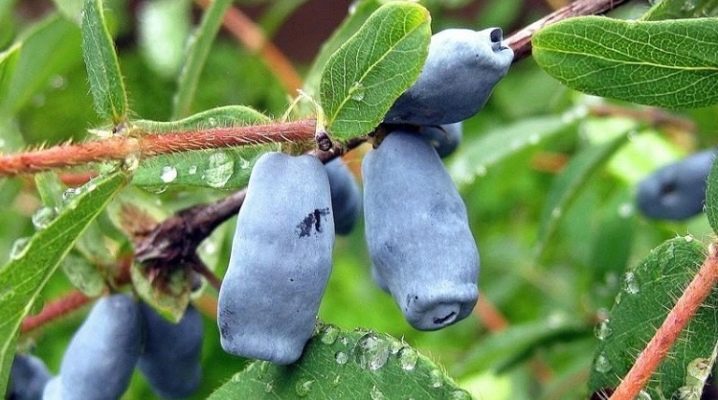
Nowadays, not everyone knows what honeysuckle is and how to grow it correctly. Moreover, this shrub is the most beneficial for human health. The berries contain whole vitamin complexes, thanks to which the plant can compete with many other representatives of the flora. Separately, it is worth focusing on the aesthetics of both edible and inedible (decorative) varieties, which are now widely used in landscape design.
general description
The plant in question belongs to the Honeysuckle family. It is a shrub that can be deciduous or evergreen.... There are straight as well as curly and creeping forms of honeysuckle bushes. The first two categories are more common in nature. It is also worth focusing on the existence of many species of this plant. Some of them bear fruit with edible and very healthy berries with good taste.
Shrub plants can have leaf plates of different shapes:
- oval;
- ellipsoidal;
- with solid edges.
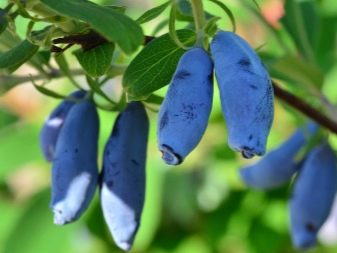

Honeysuckle leaves are characterized by a wavy edging, as well as a sharp, slightly pointed or rounded crown. In their sinuses, there are single or overlapping kidneys. The peeling bark of the bushes is brown in color. The shallow root system branches mainly in the horizontal plane. It should be noted that it is 0.5 meters higher than the deciduous arch of the shrub. Also, the peculiarities of the plant include the presence of male and female flowers, which can have both regular and irregular shapes at sufficiently large sizes.
Another distinguishing feature is in mostly pastel shades... During the flowering period, honeysuckle is decorated with white, bluish, pink and light yellow buds. The fruits of the considered representative of the flora are berries that grow in pairs and at the same time are often accrete. It is worth highlighting more than a wide color palette of berries with the following colors:
- black;
- Navy blue;
- deep blue;
- yellow;
- Orange;
- Red.
One of the key features of honeysuckle is the characteristic bloom on the fruit. At the same time, the latter have an elongated shape and a fairly rich taste. Berries, depending on the varietal variety, are sweet or sour.

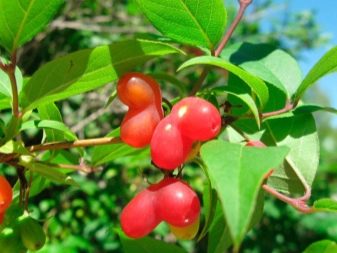
Popular species and varieties
Today, more than a wide range of varieties of honeysuckle is cultivated in Russia and other countries.... For example, Japanese variegated, which is a tropical liana with flowers, the aroma of which can spread within a radius of 10-15 m, is popular.Also, the list of common, judging by numerous reviews, representatives of the category of ornamental crops includes nodding honeysuckle and seaside (Serotina). Also noteworthy are such garden species as alpine (natural habitat - mountain forests) and Korolkov's honeysuckle. If we talk about edible species, then it is worth highlighting the Altai, Kamchatka, blue and Turchaninov's honeysuckle.
It should also be noted that cultivars whose fruits are eaten are divided into categories based on when they ripen.
- Earlybearing fruit in the middle of the first summer month."Princess Diana", "Gzhel early", "Roxana", "Blue Spindle".
- Mid-seasonyielding crops in the 3rd June decade. Shahinya, Omega, Souvenir, Cinderella.
- Late, with fruits fully ripening towards the end of June. "Ramenskaya", "Kingfisher", "Nymph", "Gourmet".
Another factor, taking into account which honeysuckle species are classified, is the size of the bush itself. In this case, we can highlight:
- undersized - height up to 1.5 m;
- medium - up to 2 m;
- tall - more than 2 m (often look like real trees).
However, in practice, modern gardeners most often divide the varieties of the described plant, taking into account the taste and other characteristics of the berries. In this regard, sweet, large-fruited and high-yielding varieties are distinguished.
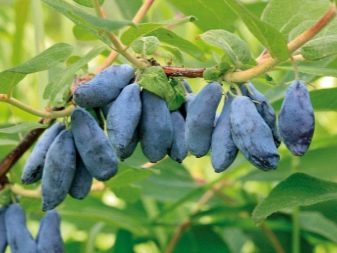
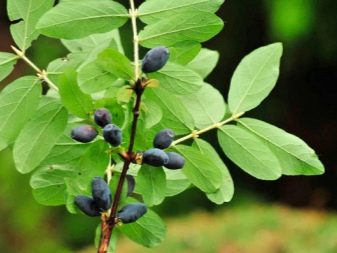
Landing
It is initially important to note that for planting, it is strongly recommended to select bushes whose height does not exceed 1.5 m. Experienced gardeners are also advised to purchase planting material of different varieties that have different taste and other characteristics. This is due to the need to ensure effective cross-pollination.
For planting seedlings, you need to choose the right site, which should be well lit. At the same time, the described shrubs take root well in partial shade conditions. Soil quality in this case does not play a key role. The landing time will be more significant. You should wait for a steady warming, when at night the thermometer will be stably above zero. It is highly undesirable to plant young growth after the buds begin to swell.
The next important point is shrub planting scheme. The distances between the disembarkation units and the rows should be between 1.5 and 2 meters, respectively.
When calculating the intervals, it is necessary to take into account such varietal characteristics as the width and height of the bushes.

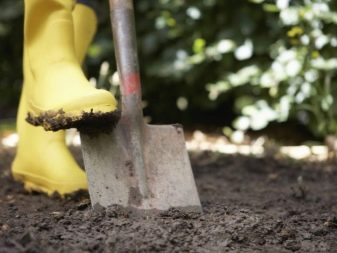
The key to active growth, full development and abundant fruiting of honeysuckle will be compliance with all planting rules, including fertilizing the hole. Each of them must be placed:
- rotted manure;
- superphosphate;
- wood ash;
- potassium sulfate.
All of these components are thoroughly mixed and a mound is formed from the resulting mixture in the pit. Further it is necessary:
- place a seedling in the center of the mound;
- carefully spread the roots of the plant, excluding bends;
- fill the hole with soil and tamp;
- water the bush abundantly.
It is worth considering that the root collar is buried into the ground by about 5 cm.At the final stage, it remains only to trap moisture to mulch the soil using sawdust, a mixture of peat and hay, or bark.

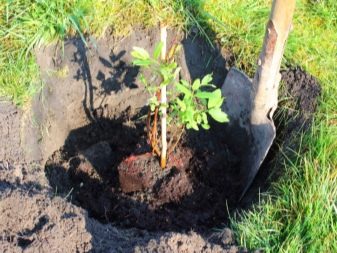
Care
As noted, honeysuckle is valued both for its outstanding palatable fruits and for its decorative properties. In order for the plant to be able to fully preserve both of these qualities for as long as possible, it must be properly looked after.
By and large, the cultivation of shrubs will not require any special efforts and costs. They need to be watered in a timely manner, get rid of weeds, loosen the soil and apply top dressing. Another important point is preventive measures aimed at preventing diseases and attacks of harmful insects.
Watering and feeding
Watering the described crop should be moderate. But it is important to take into account that in the absence of precipitation, especially at the end of May and the beginning of the summer season, the plant needs more moisture... Its lack leads to the fact that even fully ripe berries will taste bitter. Under milder weather conditions and periodic moderate rains, the bushes will need only 3-4 irrigation per season. In this case, the water consumption per unit is 10 liters.
The first few years of honeysuckle will not require fertilization. They begin to feed the shrub from the 3rd year after planting. And we are talking about organic fertilizers used at intervals of 1-2 years. They are brought in in late autumn, and in the composition of the mixture consumed per 1 sq. m, includes:
- compost - 5 kg;
- wood ash - 100 g;
- double superphosphate - 2 tbsp. l.
Many experienced gardeners prefer to feed the honeysuckle bushes with ammonium nitrate every spring at the rate of 3 tsp. to the "square". After harvesting, you can apply slurry under each bush, which is diluted with water in a ratio of 1: 4.
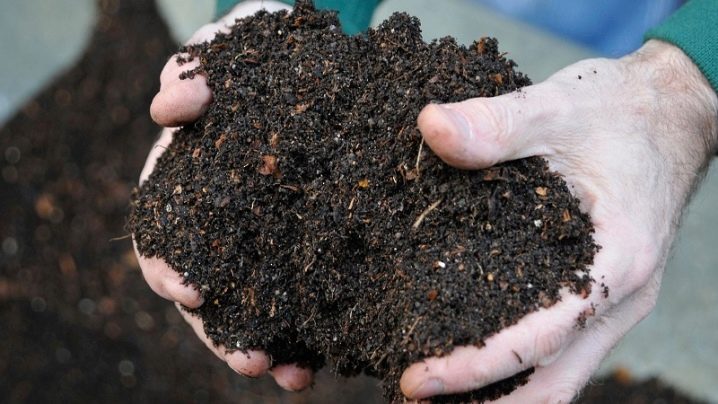
Transfer
It should be noted right away that an adult bush is quite difficult to transfer to a new place... We are talking about certain physical efforts. First of all, it must be dug in, having previously outlined the boundaries of the root system. In the next step, the honeysuckle should be carefully removed from the ground.
The plant tolerates the resettlement procedure itself without any problems. The optimal time for transplanting is summer, or rather, immediately after harvest. This approach will allow the bushes to quickly take root in a new place. It is important to provide the plant with abundant watering after completing the procedure.
Pruning
The first 2-3 years of life from the moment of planting in open ground, honeysuckle most often does not need such procedures. As practice shows, with the normal development of the bush and the absence of thickening, it makes no sense to perform early pruning. In some cases, the first such agrotechnical techniques become relevant when the bushes reach the age of 7-8 years. At the same time, some experts advise to shorten the young growth by about 8 cm immediately after planting, and then monitor the growth of green mass by the bush. In any case, pruning is recommended in the autumn.
If the shrub begins to thicken noticeably, then first of all it is worth removing the so-called zero shoots growing directly from the ground. You should also get rid of dried, damaged and short twigs, which in any case are not able to bear fruit normally.
To provide access to light inside the bush, it must be periodically thinned out. Low-growing branches are subject to removal, which complicate the processing of the soil.
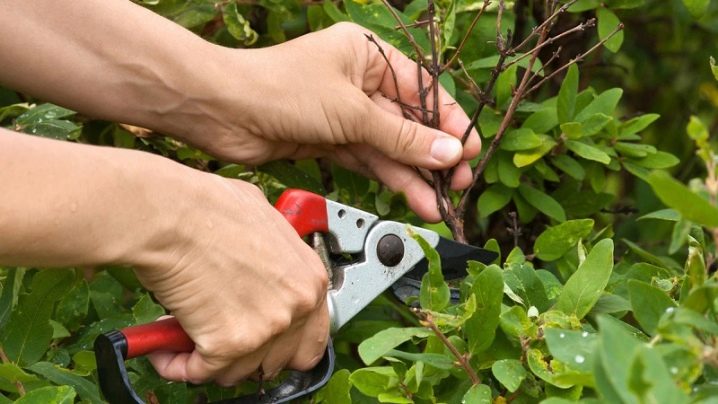
Wintering
In the overwhelming majority of cases, honeysuckle, including some of the climbing varietal varieties, tolerates winter well and does not require the creation of shelters. This, unfortunately, is not relevant for the bulk of decorative climbing species. They need preparation for the winter, which includes the following steps:
- vines are carefully removed from the supporting structures;
- shoots bend to the ground;
- cover the plant with spruce branches or other covering material.
Such manipulations will allow honeysuckle to preserve delicate and vulnerable buds during severe frosts.
Reproduction methods
In this case, we can talk about seeds and a vegetative method. Each of the options has its own advantages and no less significant disadvantages. The breeding methods that exist today are as follows.
- Seeds... The material is placed in a moist soil mixture with a minimum depth (0.1 cm). It is important to create greenhouse conditions for the seedlings, and perform the procedure itself in June. The first shoots can be expected in about 3 weeks.
- Cuttings (combined and green). In the first case, it is necessary to cut off an annual stem with green shoots after the flowering of the bush stops (May-June). It is planted to a depth of no more than 5 cm and a film shelter is created. Green cuttings are harvested at the final stage of intensive shrub growth.
- Layers... In June, the land near the bush must be loosened and slightly raised in order to separate 2-3 powerful one-year-olds. These stems are pressed to the ground, fixed in a couple of places with a wire and sprinkled with a 5-centimeter layer of soil. These shoots must be watered periodically. Next year, in the spring, it will be possible to separate the rooted layers and plant them.
- By dividing the bush... This method is relevant for plants not younger than 6 years of age. The procedure is carried out in the spring or at the beginning of the autumn period.The bush is carefully removed from the ground and divided into segments using a pruner or a hacksaw. Places of cuts must be disinfected.
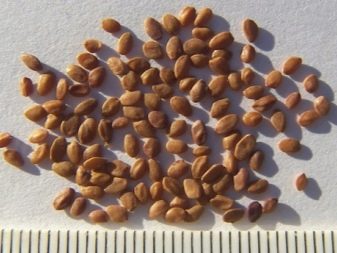
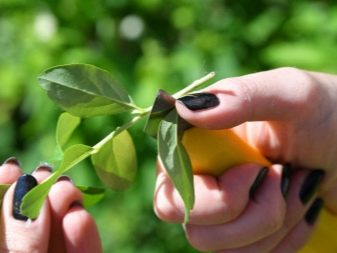
Diseases and pests
It is believed that all varieties of the described shrub are highly resistant to infections and attacks of harmful insects. With timely and competent prevention, in most cases it is possible to avoid most of the troubles in the cultivation of honeysuckle. At the same time, when even the smallest symptoms appear, the most effective measures should be taken immediately.
The following pests pose the greatest danger to plants.
- Cherry fly. In this case, we are talking about the appearance on various parts of plants of white worms, which are the larvae of the parasite. It causes significant damage, damaging the fruit and oppressing the bush. The most effective remedy will be the use of insecticides.
- Aphid... The presence of this pest is evidenced by the pale tops of shoots and leaf plates. The insect actively sucks nutrients from plant tissues. In spring, treatment with such popular drugs as "Karate", "Confidor" and "Actellik" is used as a preventive measure. In parallel, it can be successfully used for spraying infusions of pepper, onion, garlic and tobacco.
- Leaf roll... The main symptom of an attack by this parasite is the twisting of the leaf plates into tubes. Treatment at the initial stage of vegetation with "Aktara" and "Fufanon", as well as biological products will be effective.
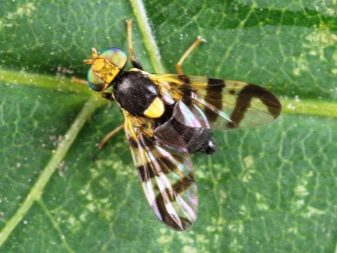
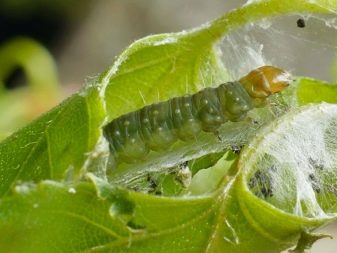
Today, experienced gardeners, as part of the care of honeysuckle of different varieties, effectively use both modern drugs and proven and time-tested folk remedies for pest control.
The described plant is susceptible to the same diseases as other inhabitants of garden and backyard plots. It is worth highlighting the common ailments of honeysuckle.
- Ramulariasisthat infects bushes most often in wet and cool weather. The disease can be determined by the formation of gray-brown spots on the leaf plates and the appearance of white bloom on them. Effective means in this case will be "Horus", "Fundazol" and "Oxyhom".
- Mosaic, which is a foliar disease and manifests itself primarily as spots of bright yellow color. Unfortunately, this virus does not respond to treatment, and therefore the affected plant must be immediately dug up and destroyed.
Also, honeysuckle suffers from cercosporosis, powdery mildew, rust and fungal diseases, including black soot. All of these ailments are much easier to prevent, observing the rules of agricultural technology, than to treat and eliminate their consequences.


Application in landscape design
Nowadays, honeysuckle is widely and successfully used by designers in the design of a wide variety of areas. In particular, aesthetic hedges are formed from these bushes. They look spectacular as elements of all kinds of landscape compositions.


Lianas allow you to create original and aesthetic arches, decorate gazebos, as well as decorate vertical elements of buildings with landscaping... Often, honeysuckle bushes are used for zoning areas.














The comment was sent successfully.